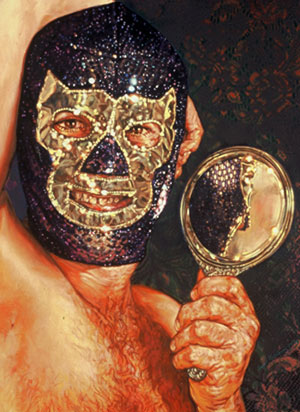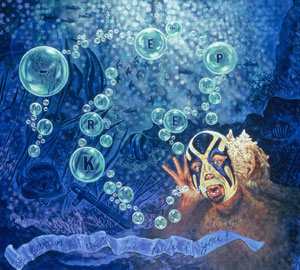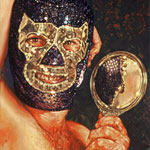Like many of his fellow countrymen, the Cuban writer Alejo Carpentier thought highly of baroque art.
He challenged the idea of the baroque as decadent, claiming that decadence has been systematically applied to a multitude of artistic manifestations that, far from representing decadence, represent cultural summits (he used the examples of Beethoven and Bernini). Carpentier spoke of the baroque (with a small b) not so much as time period, but as a spirit. He described the New World, specifically the Caribbean and Latin America, as being spaces with organic baroque tendencies.
It would seem no fluke then that the work of Angel Rodriguez-Diaz, a native of Puerto Rico, might classify as modern baroque. His portraits of luchadores (masked Mexican wrestlers), on view now at the Rudolph Projects | ArtScan Gallery, are in many ways examples of baroque portraiture.
Tropes of the baroque are mirrors, stage curtains, roses, doubling and the intentional blurring of real and unreal/art and reality. The layers of self-representation in all the paintings is most extreme in the piece entitled Rey Misterio.Who Are You?…Come out King Mystery. Who are you? In all the paintings, a background of a tapestry or frou-frou wall paper seems to be intentionally staged. These dolled-up wrestlers are not in the ring; they’re not even about to fight. They are posing. In Rey Misterio, the background is a deep blue print of delicate flowers. A mirror hangs on the wall, and the wrestler is seen only as a reflection in the mirror. He looks off to the right of the canvas to a person whose arm enters the canvas from the left — the reflection of the mirror confusing the image. The arm, sporting a silky shirt cuff, does not seem to be the wrestler’s (who wears a black leather jacket). We realize this is a double self-portrait, of the artist’s hand as well as the artist-as-wrestler. The mirror, the mask and the disembodied hand all distance the portrait from the original subject.
Together, these elements confuse reality with fiction by adding more and more representations. The baroque dichotomy between the real and the fantasy is embodied in Rey Misterio by the thick red stage curtain, roped open to reveal the mirror. The mirror, then, is on the stage — a pretense. Carpentier spoke of the baroque as a form that feared a vacuum. In this painting, the many layers of the real-self are compounded and confused and re-revealed.
Rodriguez-Diaz explains that the masks in the Luchadores paintings represent another way of being seen. As a Puerto Rican, his choice to leave the Caribbean and live in the United States, in a Latino culture that is not the one of his birth, has expanded the idea of his native culture. The predominant Latin American culture in San Antonio is Mexican, and though the language is the same, there remain fundamental cultural differences between Caribbean Spanish speakers and those from Central or South America. While in San Antonio, Rodriguez-Diaz may be taken for Mexican, though he is not. In these paintings, he emphasizes the primarily Mexican phenomena of the Luchadores, while behind the masks is the artist himself, a Puerto Rican. That the wrestlers seem effeminate (the wrestler in You Fool looks into the mirror as if preening) or childish (the wrestler in Alebrije plays with a superman action figure) or even seem to defy both a Mexican and a Puerto Rican self (in Chino Latino the wrestler has a Chinese mask and holds up a Chinese lantern) is a further and intentional disruption of identity.
Ultimately, these paintings all comment on the politics of identity (and the identity in politics). Atlantis has a background of tropical fish. The luchadora spits bubbles in an attempt to spell out Preemptive Strike. Strike is spelled out, but preemptive is missing letters. It’s clearly a commentary on the US war in Iraq; but who is the commentator? Not a stereotypical American liberal, but instead a masked Mexican/Puerto Rican wrestler, holding his breath under water.
Images courtesy the artist and Rudolph Projects | ArtScan Gallery.
Tiphanie Yanique is a writer lving in Houston.





